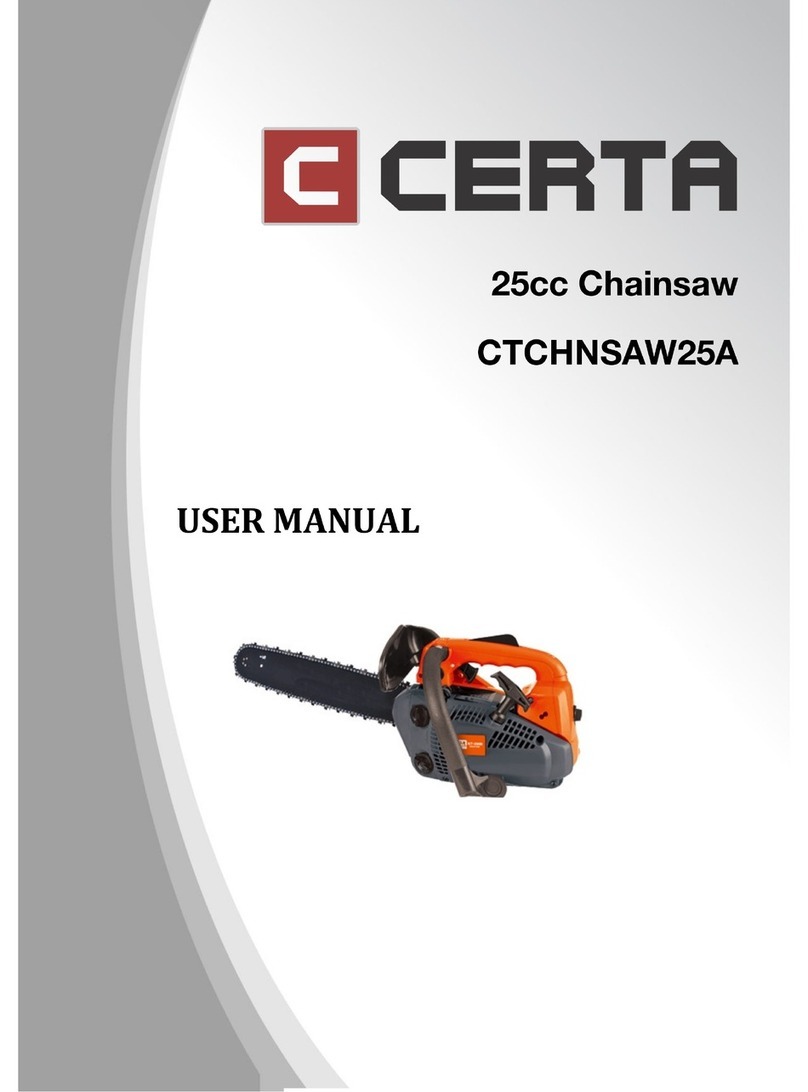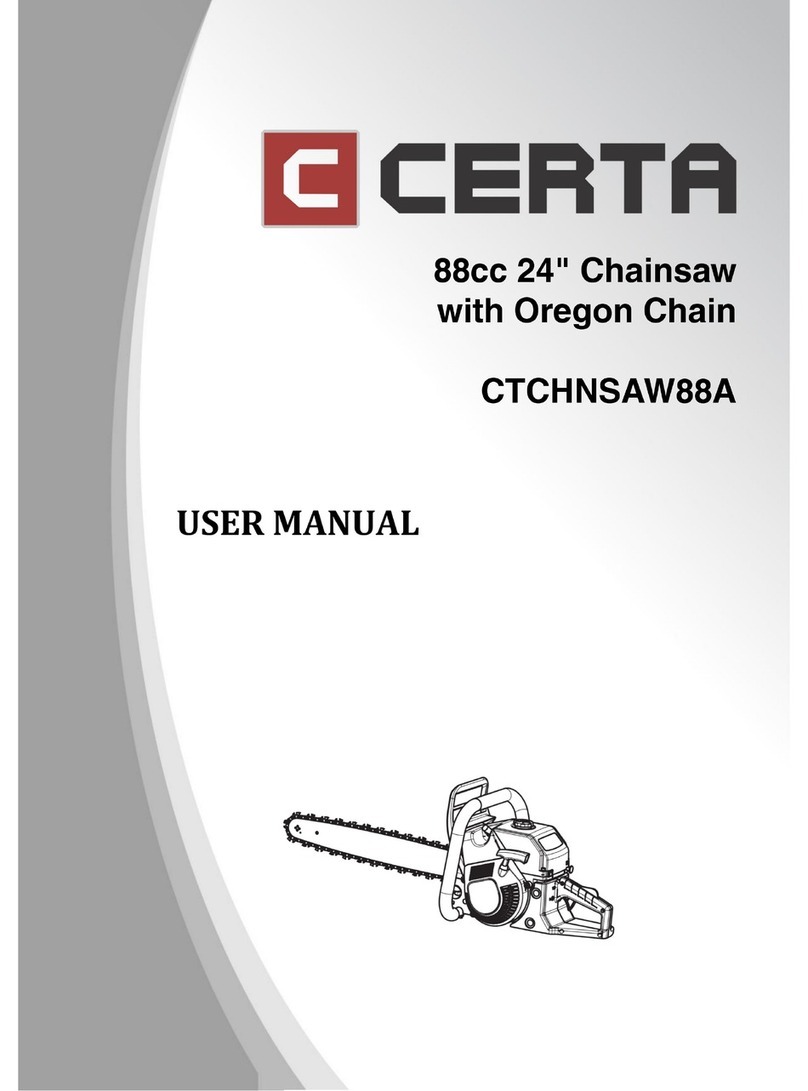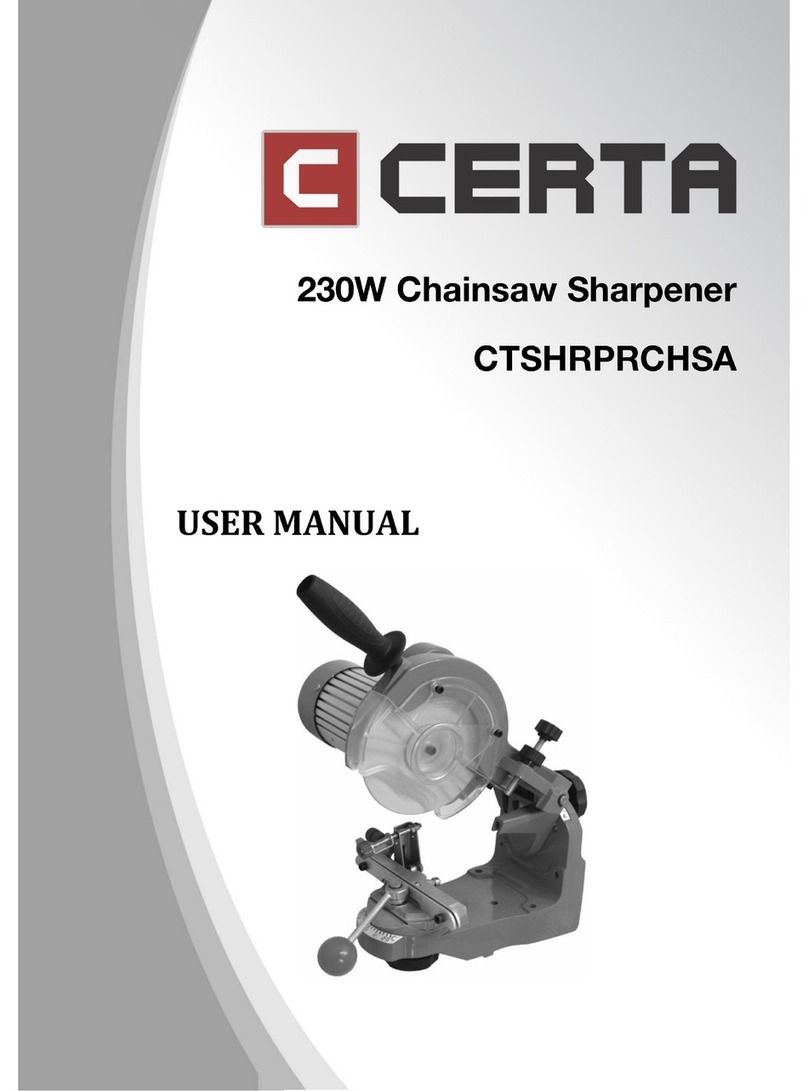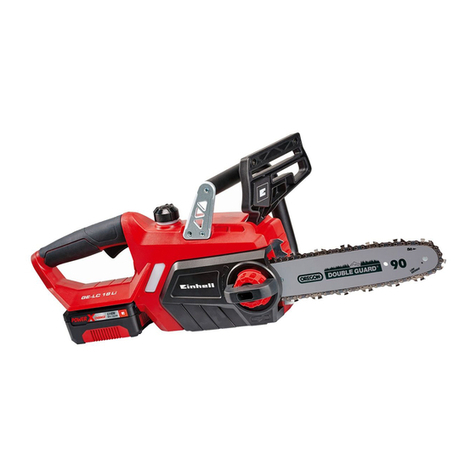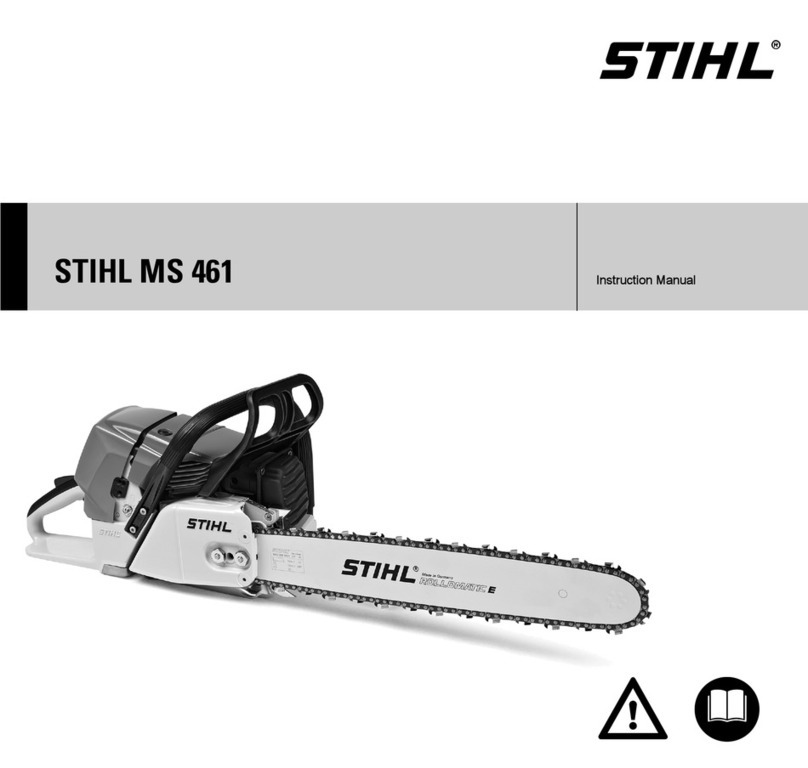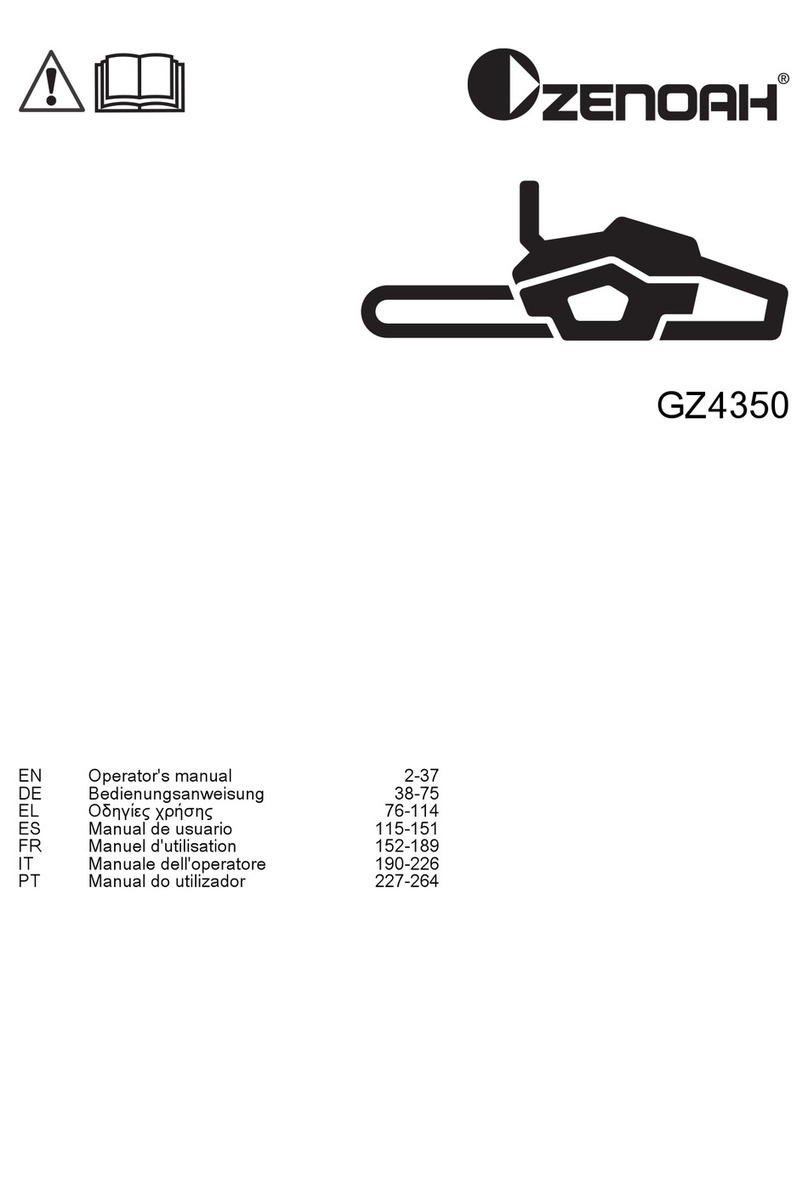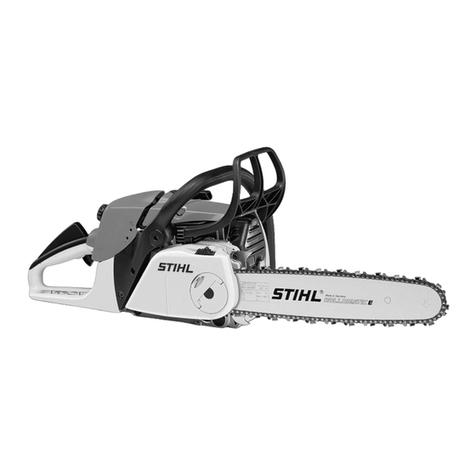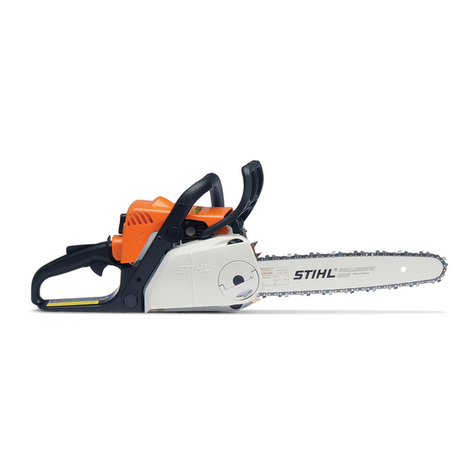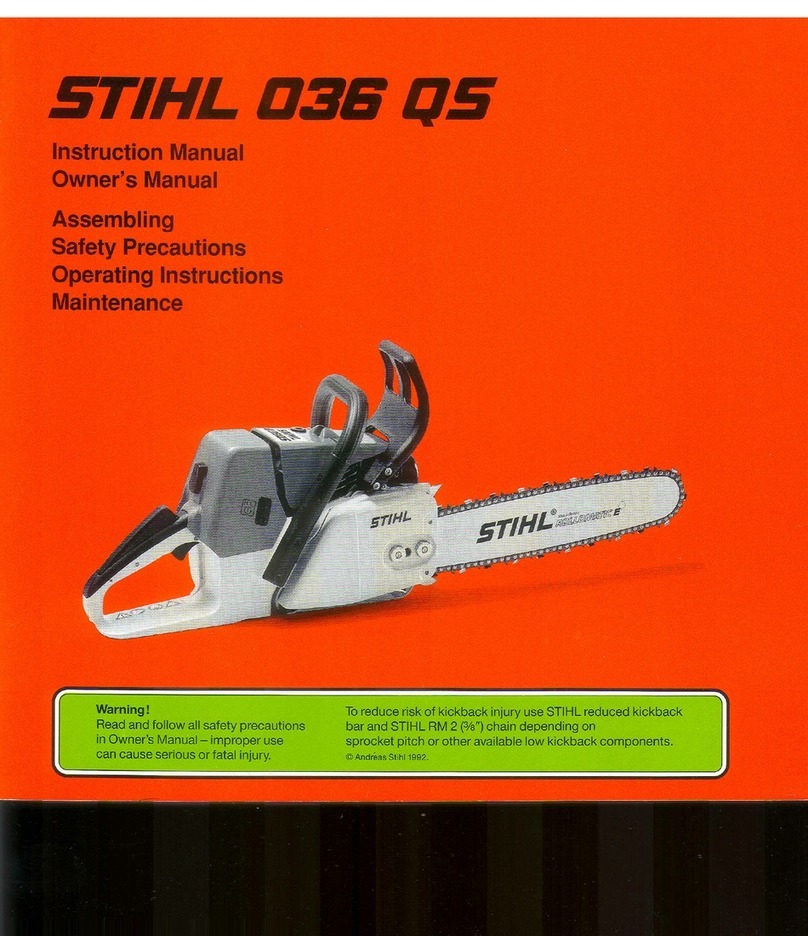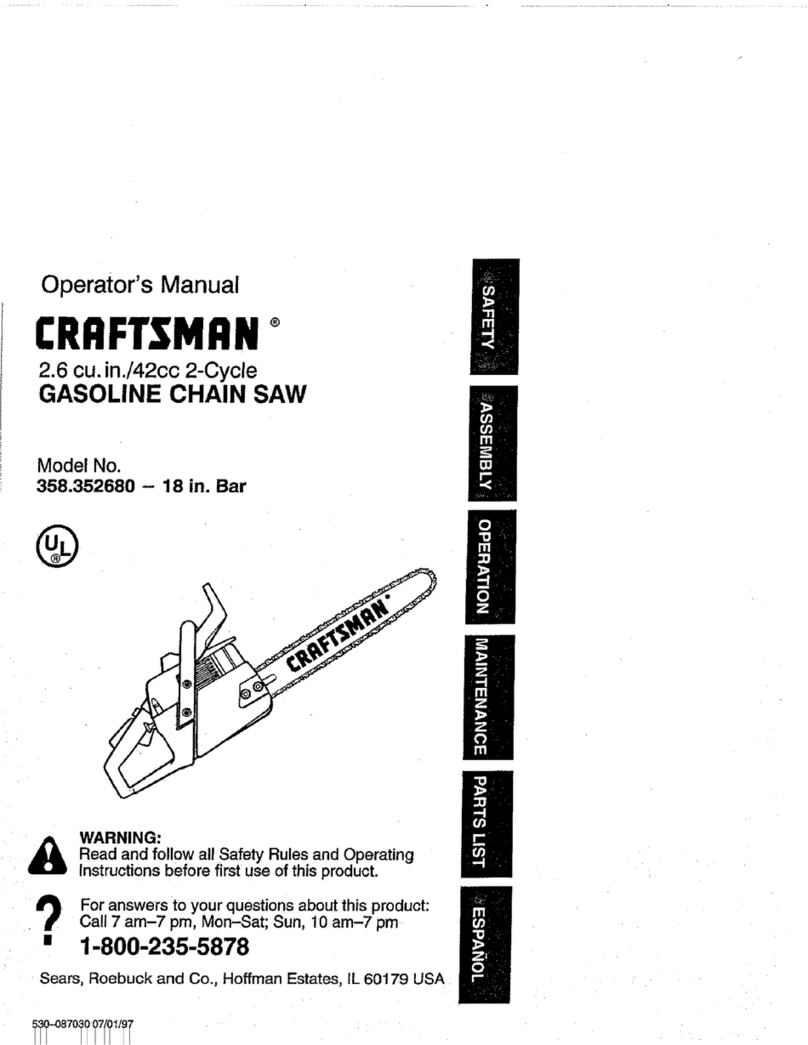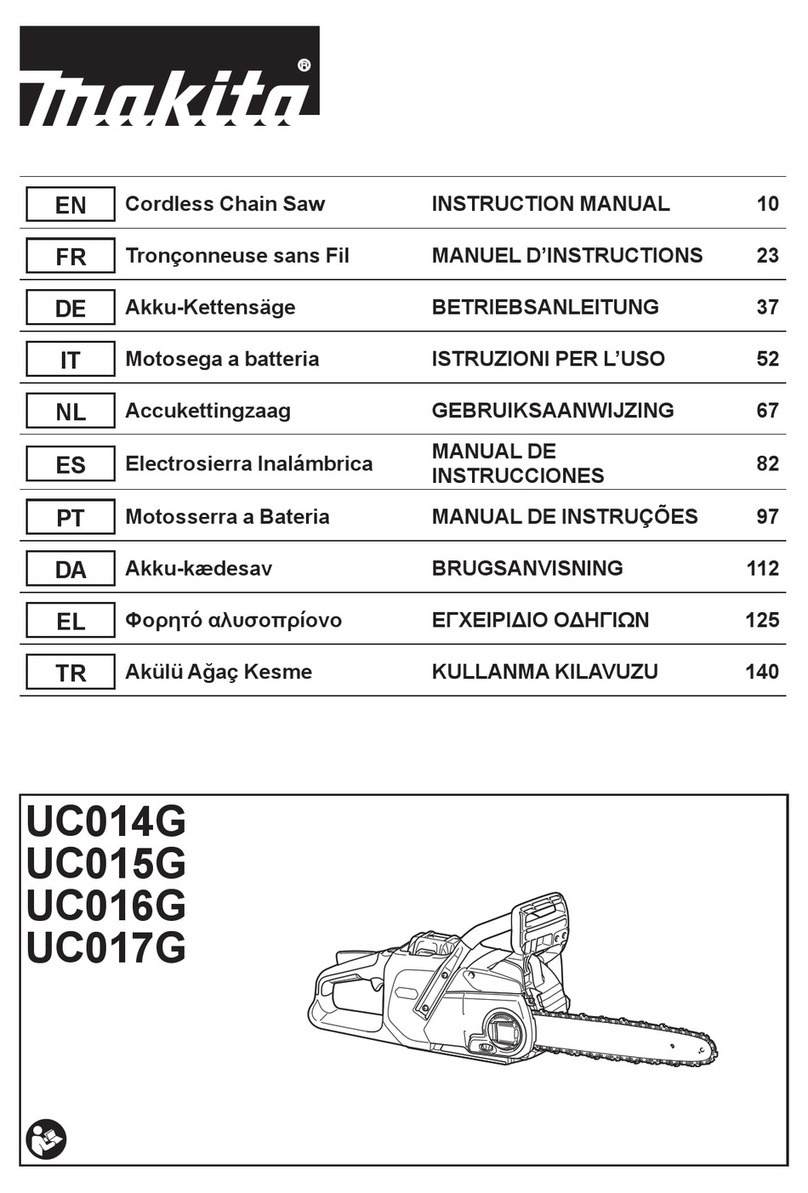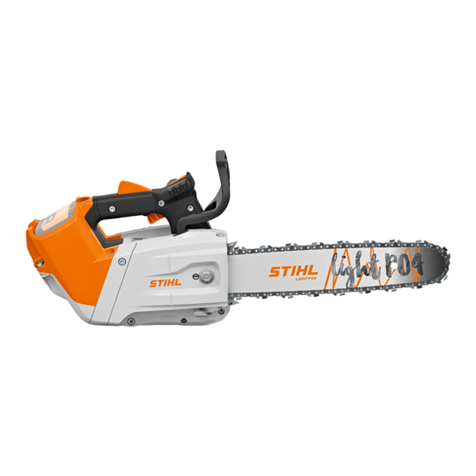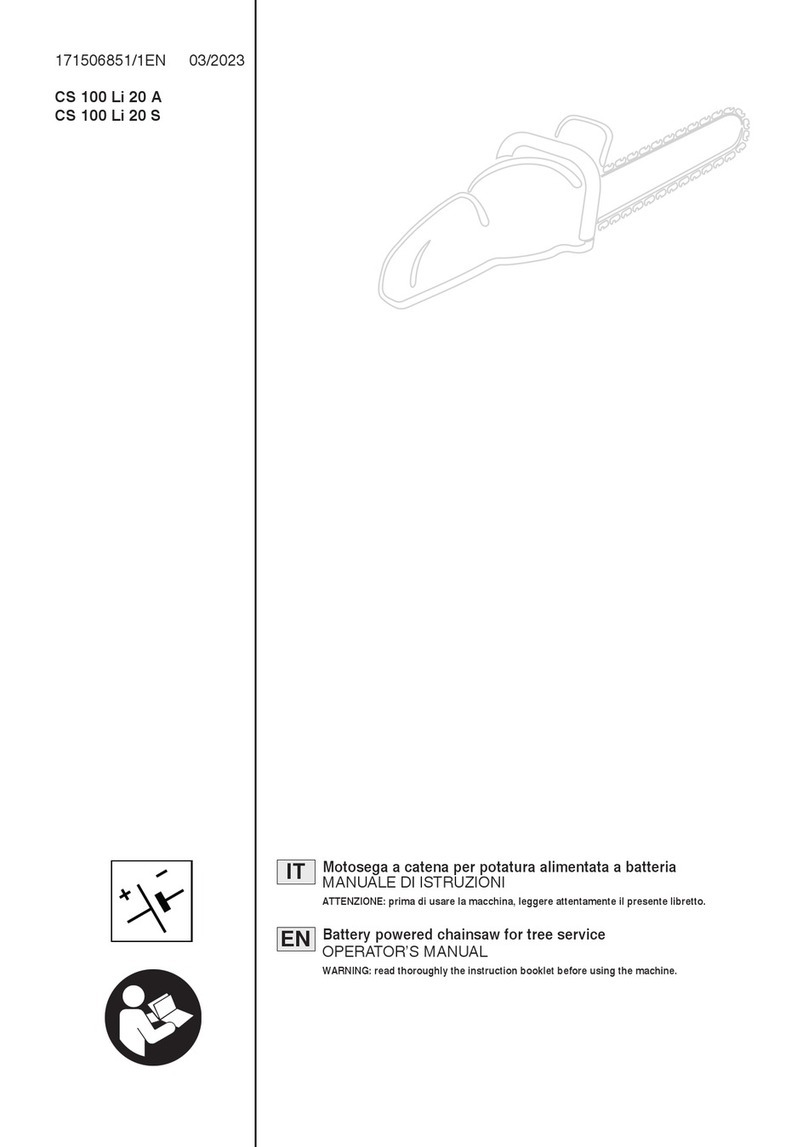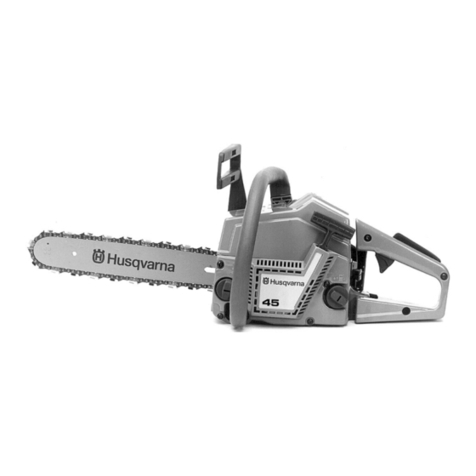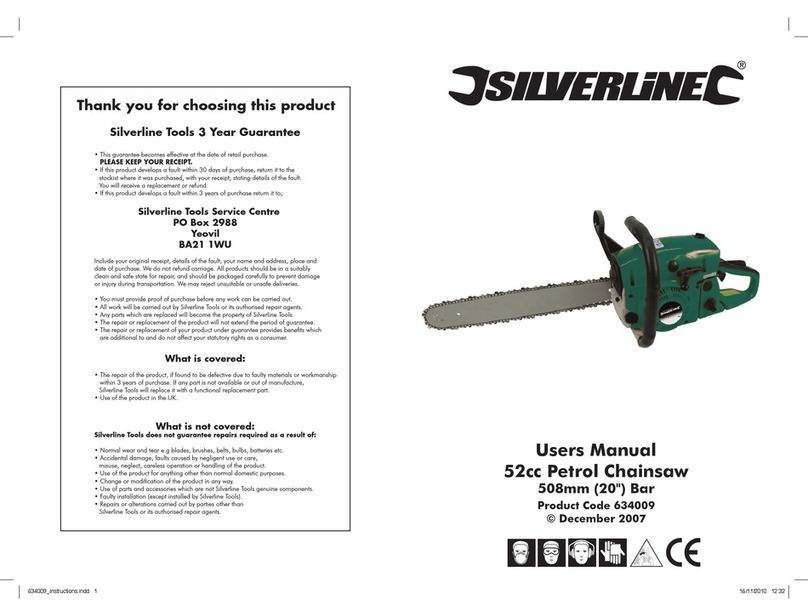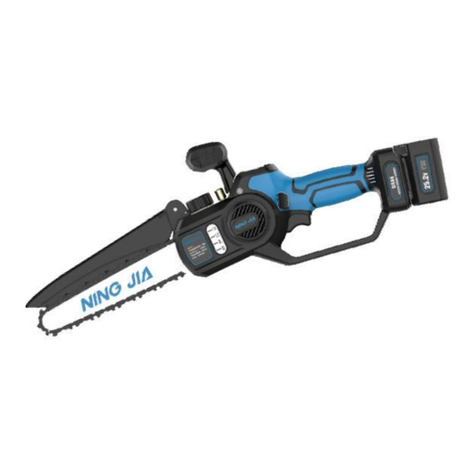Certa CTCHNSAW88A User manual


Table of Contents
Safety Warnings............................................................................................................................................................. 2
Different Warning Types........................................................................................................................................ 2
Chainsaw Layout............................................................................................................................................................ 2
Warning Labels on the Chainsaw.......................................................................................................................2
Symbols on the Chainsaw..................................................................................................................................... 3
Safety Precautions......................................................................................................................................................... 3
Before se.................................................................................................................................................................. 3
Work Gear and Clothing........................................................................................................................................4
Handling of Fuel....................................................................................................................................................... 4
Before Starting the Engine................................................................................................................................... 4
Starting the Engine.................................................................................................................................................. 4
Operation.................................................................................................................................................................... 4
Kickback Safety Precautions................................................................................................................................ 5
Maintenance............................................................................................................................................................... 5
Transportation........................................................................................................................................................... 5
Installing Guide Bar and Saw Chain.........................................................................................................................5
Fuel and Chain Oil......................................................................................................................................................... 6
How to Mix Fuel........................................................................................................................................................ 6
Fuelling the nit....................................................................................................................................................... 6
Chain Oil...................................................................................................................................................................... 7
Starting the Engine....................................................................................................................................................... 7
Checking Oil Supply...................................................................................................................................................... 8
Adjusting the Carburettor........................................................................................................................................... 8
Chain Brake...................................................................................................................................................................... 9
Stopping the Engine..................................................................................................................................................... 9
Sawing............................................................................................................................................................................... 9
Guard Against Kickback.............................................................................................................................................. 9
Felling a Tree.................................................................................................................................................................. 10
Bucking and Limbing............................................................................................................................................ 10
Maintenance................................................................................................................................................................... 10
Maintenance after each use................................................................................................................................ 10
Periodical Service Points....................................................................................................................................... 11
Maintenance of Saw Chain and Guide Bar.....................................................................................................12
Troubleshooting Guide............................................................................................................................................... 13
Product Specifications............................................................................................................................................... 14
1

Safety Warnings
Instructions contained in warnings within this manual marked with a symbol
concern critical points which must be taken into consideration to prevent
possible serious bodily injury, and for this reason you are requested to read all
such instructions carefully and follow them without fail.
Different Warning Types
This mark indicates instructions which must be followed in order to prevent accidents which could lead to
serious injury or death.
This mark indicates instructions which must be followed in order to prevent mechanical failure, breakdown or
other damage to the chainsaw or workpiece.
This mark indicates hints or directions useful in the use of the chainsaw.
Chainsaw Layout
1. Front Guard 2. Starter Knob 3. Air Filter 4. Choke Knob
5. Throttle Interlock 6. Rear Handle 7. Throttle Trigger 8. Engine Switch
9. Fuel Tank 10. Oil Tank 11. Front Handle 12. Saw Chain
13. Guide Bar
Warning Labels on the Chainsaw
Read the full owners manual before operating the chainsaw.
Wear head, eye and ear protection.
se the chainsaw with two hands at all times.
Warning! Kickback danger!
Warning/Attention!
If warning seals peel off or become soiled and impossible to read, you should contact a hardware store and
request replacement seals that can be used to replace them.
2

Symbols on the Chainsaw
For safe operation and maintenance, symbols are carved in relief on the machine. According to these indicators, take
care to follow the instructions and avoid mistakes.
The refuelling port.
Position: Fuel Cap.
The oil reservoir port.
Position: Oil Cap.
Set the switch to the I position to start the engine.
Set the switch to the O position to stop the engine immediately.
Position: front top of the rear handle.
When starting the engine, pulling out the choke knob on the back-right of the rear handle, you can
set the starting mode as follows:
•First-stage: starting mode when the engine is warm
•Second-stage: starting mode when the engine is cold
Position: upper-right of the air filter cover.
HThe screw under the “H” stamp is the high-speed adjustment screw.
LThe screw under the “L” stamp is the slow-speed adjustment screw.
TThe screw to the left of the “T” stamp is the idle adjustment screw.
Position: left side of the rear handle.
Shows the direction for the train brake being released (white arrow) or activated (black arrow).
Position: front of the chain cover.
If you turn the rod with a screwdriver to follow the arrow direction to the MAX position, more chain
oil will flow. If you turn the rod backwards towards the MIN position, less chain oil will flow.
Position: bottom of the power unit.
Safety Precautions
Before Use
•Read this owner's manual carefully to understand how to operate this unit properly.
•You should never use the product when under the influence of alcohol, when suffering from
exhaustion or lack of sleep, when suffering from drowsiness as a result of having taken cold
medicine, or at any other time when a possibility exists that your judgement might be impaired or
that you might not be able to operate the machine properly and in a safe manner.
•Avoid running the engine indoors. The exhaust gases contain harmful carbon monoxide.
•Never use the product under circumstances like those described below:
✗When the ground is slippery or when other conditions exist which might make it not possible to
maintain a steady posture
✗At night, at times of heavy fog, or at any other times when your field of vision might be limited
and it would be difficult to gain a clear view of the area.
✗During rain storms, during lightning storms, at times of strong or gale-force winds, or at any
other times when weather conditions might make it unsafe to use this product.
✗When using this product for the first time, before beginning actual work, learn to handle it from
skilled worker.
✗Lack of sleep, tiredness, or physical exhaustion results in lower attention spans, and this in turn
leads to accidents and injury. Limit the amount of time of using the machine continuously to
somewhere around 10 minutes per session, and take 10 ~ 20 minutes of rest between work
sessions. Also try to keep the total amount of work performed in a single day under 2 hours or
less.
✗Be sure to keep this manual handy so that you may refer to it later whenever any questions
arise.
✗Always be sure to include this manual when selling, lending or otherwise transferring the
3

ownership of the product.
✗Never allow children or anyone unable to fully understand the directions given in this manual to
use this product.
Work Gear an Clothing
•When using the product, you should wear proper clothing and protective equipment as follows.
1) Helmet
2) Protection goggles or face Protector
3) Thick work gloves
4) Non-slip-sole work boots
5) Ear protectors
•You should carry with you.
1) Attached tools and files.
2) Properly reserved fuel and chain oil.
3) Things to notify/secure your working area (Rope, warning signs..)
4) Whistle (for collaboration or emergency)
5) Hatchet or saw (for removal of obstacles)
•Never use the product when wearing pants with loose cuffs, when wearing sandals, or when
barefoot.
Han ling of Fuel
•The engine of this product is designed to run on a mixed fuel which contains highly flammable
gasoline. Never store cans of fuel or refill the fuel tank in any place where there is a boiler stove,
wood fire, electrical sparks, welding sparks, or any other source of heat or fire which might ignite
the fuel.
•Smoking while operating the product or refilling its fuel tank is extremely dangerous. Always be
sure to keep lit cigarettes away from the product at all times.
•When refilling the tank always turn off the engine first and take a careful look around to make sure
that there are no sparks or open flames anywhere nearby before refuelling.
•lf any fuel spillage occurs during refuelling, use a dry rag to wipe up spills before turning the engine
back on again.
•After refuelling, screw the fuel cap back tightly onto the fuel tank and then carry the product to a
spot 3m or more away from where it was refuelled before turning on the engine.
Before Starting the Engine
•Check working place, the cutting object and cutting direction. If there is obstacle, remove it.
•Never start cutting until you have a clear work area, secure footing and a planned retreat path from
the falling tree.
•se caution and keep bystanders and animals out of the working area, which is a diameter of 2.5
times the length of the cutting object.
•Inspect the machine for worn, loose, or damaged parts. Never operate the machine that is
damaged, improperly adjusted, or is not completely and securely assembled. Make sure that the
saw chain stops moving when the throttle control trigger is released.
Starting the Engine
•Always hold the machine firmly with both hands whenever the engine is running. se a firm grip
with thumb and fingers encircling the handles.
•Keep all parts of your body away from the machine when the engine is running.
•Before starting the engine, make sure the saw chain is not in contact with anything.
Operation
•Keep the handles dry, clean and free of oil or fuel mixture.
•Never touch the muffler, spark plug or other metallic parts of the engine while the engine is in
operation or immediately after stopping the engine. Doing so could result in serious burns or
electrical shock.
•se extreme caution when cutting small size brush and saplings because slender material may
catch the saw chain and be whipped toward you, or pull you off balance.
4

•When cutting a limb that is under tension, be alert for spring back to ensure that you won't be
struck when the tension in the wood fibers are released
•Check the tree for dead branches that could fall during the felling operation.
•Always shut the engine off before setting the chainsaw down.
Kickback Safety Precautions
•Kickback may occur when the nose or tip of the guide bar touches an object, or when the wood
closes in and pinches the saw chain in the cut. Tip contact in some cases may cause a lightning fast
reverse reaction, kicking the guide bar up and back towards the operator. Pinching the saw chain
along the top of the guide bar may push the guide bar rapidly back towards the operator. Either of
these reactions may cause you to lose control of the saw which could result in serious personal
injury.
•Do not rely exclusively on the safety devices built into your saw. As a chain saw user you should
take several steps to keep cutting jobs free from accident or injury:
1. With a basic understanding of kickback, you can reduce or eliminate the element of surprise.
Sudden surprises contribute to accidents.
2. Keep a good grip on the saw with both hands, the right hand on the rear handle and the left
hand on the front handle when the engine is running. se a firm grip with thumbs and fingers
encircling the chain saw handles. A firm grip will help you reduce kickback and maintain control
of the saw.
3. Make certain that the area in which you are cutting is free from obstructions. Do not let the
nose of the guide bar contact a log, branch, or any other obstruction which could be hit while
you are operating the saw.
4. Cut at high engine speeds.
5. Do not overreach or cut above shoulder height.
6. Follow sharpening and maintenance instructions for saw chain.
7. Only use replacement bars and chains specified by Kogan.com customer support.
Maintenance
•In order to maintain your product in proper working order, perform the maintenance and checking
operations described in the manual at regular intervals.
•Always be sure to turn off the engine before performing any maintenance or checking procedures.
The metallic parts reach high temperatures immediately after stopping the engine.
Transportation
•Always carry the unit with the engine stopped, the guide bar covered with the protector to the rear
and the muffler away from your body.
Installing Gui e Bar an Saw Chain
A standard saw unit package contains the items as illustrated.
(1) Power unit
(2) Bar protector
(3) Guide bar
(4) Chainsaw
(5) Plug wrench
(6) Screwdriver for carburettor adjustment
Open the box and install the guide bar and the saw chain on the power unit as follows:
The saw chain has very sharp edges. se thick protective gloves for safety.
1. Pull the guard towards the front handle to check that the chain brake is not on.
2. Loosen the nuts and remove the chain cover.
3. Gear the chain to the sprocket and, while fitting the saw chain around the guide
bar, mount the guide bar to the power unit. Adjust the position of chain
tensioner nut.
5

Pay attention to the correct direction of the saw chain.
5. Fit the chain cover to the power unit and fasten the nuts to finger tightness.
6. While holding up the tip of the bar, adjust the chain tension by turning the tensioner screw until
the tie straps just touch the bottom side of the bar rail.
7. Tighten the nuts securely with the bar tip held up (12 - 15 Nm), then check the chain for smooth
rotation and proper tension while moving it by hand. If necessary, readjust with the chain cover
loose.
8. Tighten the tensioner screw.
A new chain will expand its length is the beginning of use.
Check and readjust the tension frequently as a loose chain can easily
derail or cause rapid wear of itself and the guide bar.
Fuel an Chain Oil
Fuel is highly flammable. Avoid smoking or bringing any flames or sparks nearby.
•Make sure you stop the engine and allow it to cool before attempting to refuel the unit.
•Select an outdoor location with bare ground for refuelling. Once refuelled, move the unit
to a location at least 3 metres away from the refuelling point before attempting to start
the engine.
•The engines are lubricated by oil specially formulated for air-cooled, 2-cycle gasoline
engine use. se an anti-oxidant added quality oil, expressly labelled for air-cooled, 2-
cycle engine use.
•Do not use BIA or TCW (2-stroke water-cooling type) mixed oil.
•Recommended mixing ration is Fuel 25:Oil 1.
•Exhaust emissions are controlled by the fundamental engine parameters and components
(eg carburettor, ignition timing and port timing), without addition of any major hardware,
or the introduction of an inert material during combustion.
•These engines are certified to operate on unleaded fuel.
•Ensure you use fuel with a minimum octane number of 89. se of a fuel with a lower
octane levels than prescribed may create a danger of high engine temperatures, or
pistons seizing.
•Poor quality fuel or oil may result in damage to the sealing rings, fuel lines or fuel tank.
How to Mix Fuel
Pay attention to agitation.
•Measure out the quantities of fuel and oil to be mixed.
•Put some of the fuel into a clean, approved fuel container.
•Pour in all of the oil, then agitate well.
•Pour in the rest of the fuel, then agitate again for at least one minute. As some oils may
be difficult to agitate depending on the oil ingredients, sufficient agitation is necessary
for the engine to be adequately protected. Be mindful that insufficient agitation will
increase the danger of early piston seizing due to an abnormally lean mixture.
•Put a clear indication on the outside of the container to avoid confusing this mixture for
regular fuel or other containers.
Fuelling the Unit
•ntwist and remove the fuel cap. Rest the cap on a dust free surface.
•Put fuel into the fuel tank to 80% of the full capacity.
•Fasten the fuel cap securely, then wipe any fuel spillages around the unit.
6

IMPORTANT NOTES:
•Avoid raw fuel (fuel with no oil): this will cause severe damage to the internal engine
parts of the unit very quickly.
•Avoid fuel with alcohol content: this will cause rapid deterioration of rubber and plastic
parts, plus it will disrupt engine lubrication.
•Avoid fuel for 4-cycle engines: this can cause spark plug foulage, exhaust port blockage
or piston ring seizure.
•Avoid using mixed fuels that have been left unused for extended periods of time, as this
may clog the carburettor and result in the engine failing to operate.
Chain Oil
se motor oil SAE #10W-30 all year round, or SAE 30~ #40 in summer and SAE #20 in winter.
Starting the Engine
It is very dangerous to run a chainsaw that has any broken or missing parts. Before
starting the engine, make sure that all parts, including the bar and chain, are installed properly.
1. Fill fuel and chain oil tanks respectively, and tighten the caps securely.
2. Put the switch to "I" position.
3. While holding the throttle lever together with the throttle interlock, push in the side
throttle lock button and release the throttle lever to hold it at the starting position.
NOTE: when restarting immediately after stopping the engine, set the choke knob to the
first-stage position.
NOTE: Once the choke knob has been pulled out, it will not return automatically to the
operating position. Do not push it down. To return it, pull the throttle lever out.
7

4. While holding the saw unit securely on the ground, pull the starter rope vigorously.
DO NOT start the engine while holding the chainsaw in the air by hand. The saw chain
may touch your body.
5. When engine has ignited first, push in the choke knob to the first-stage position, then pull
the starter again to start the engine.
6. Allow the engine to warm up with the throttle lever pulled slightly.
Keep clear of the saw chain as it will start rotating upon starting the engine.
Checking Oil Supply
Make sure to set up the bar and chain when checking the oil
supply. If you don't rotating parts may be exposed and is extremely
dangerous. After starting the engine, run the chain at medium speed
so you can check to see if chain oil splashes off as shown to right.
Chain oil flow can be changed by inserting a screwdriver into the hole on
the bottom of the clutch side. Adjust it according to your work conditions.
The oil tank should become nearly empty by the time fuel is used up. Be sure to refill the oil tank every time
when refuelling the unit.
A justing the Carburettor
The carburettor on your unit has been factory adjusted, but may require fine tuning due to change in
operating conditions. Before adjusting the carburettor, make sure that provided are clean air/fuel filters and
fresh, properly mixed fuel. We recommend if possible, getting your carburettor tuned by a specialist, as an
incorrect adjustment may result in damage to the unit.
When adjusting, take the following steps:
Be sure to adjust the carburettor with the bar chain attached.
1. Stop engine and screw in both H and L needles until they stop. Never force them. Then set them
back the initial number of turns as shown below.
H needle: 1/4 | L needle: 1/4
2. Start engine and allow it to warm up at half-throttle for a few
minutes.
3. Turn idle adjusting screw (T) counter-clockwise to that saw chain
does not turn. If idling speed is too slow, turn the screw clockwise.
4. Make a test cut and adjust the H needle for best cutting power,
not for maximum speed.
Over revolution of the H needle will cause a lack of power or poor
acceleration. In such a case, please turn the H needle counter-clockwise.
8

Chain Brake
This machine is equipped with an automatic brake to stop saw chain
rotation upon occurrence of kickback while in saw cutting operation.
The brake is automatically operated by inertial force which acts on
the weight fitted inside the front guard. This brake can also be
operated manually with the front guard turned down to the guide
bar.
To release brake, pull up the front guard toward the front handle till a
“click” sound is heard.
Be sure to confirm brake operation during the daily inspection.
To check the brake is working:
1. Turn off the engine.
2. Holding the chainsaw horizontally, release your hand from the front handle, then hit the tip of the
guide bar on a stump or a piece of wood and confirm brake operation.
3. If the brake is not effective, please turn the chainsaw off and contact a service agent.
If the engine is kept operating at high speed with the brake engaged, the clutch will heat up causing further
trouble. When the brake is operated during use, immediately release your fingers from the throttle lever to
keep the engine idling.
Stopping the Engine
1. Release the throttle lever to allow the engine idling for a few minutes.
2. Put the switch to the “O” (STOP) position. ( 1 = Switch)
Sawing
Before starting on your cutting job, read the “For Safe Operation” section. It is recommended to first
practice sawing on easy logs. This will also help you to get accustomed to your chainsaw.
•Always follow the safety regulations. The chain saw must only be used for cutting wood. It is
forbidden to cut other types of material. Vibrations and kickback vary with different materials. Do
not use the chain saw as a lever for lifting, moving or splitting objects . Do not lock it over fixed
stands. It is forbidden to hitch tools or accessories to the chainsaw that are not specified by
Kogan.com.
•It is not necessary to force the saw into the cut. Apply only light pressure while running the engine
at full throttle.
•When the saw chain is caught in the cut, do not attempt to pull it out by force, but use a wedge or
a lever to open the way.
Guar Against Kickback
•This saw is equipped with a chain brake that will stop the chain in the event of kickback if operating
properly. You must check the chain brake operation before each usage by running the saw at full
the throttle for 1-2 seconds and pushing the front hand guard forward. The chain should stop
immediately with the engine at full speed. If the chain is slow to stop or does not stop, replace the
brake band and clutch drum before use.
•It is extremely important that the chain brake be checked for proper operation before each use and
that the chain be sharp in order to maintain the kickback safety level of this saw. Removal of the
safety devices. Inadequate maintenance, or incorrect replacement of the bar or chain may increase
the risk or serious personal injury due to kickback.
9

Felling a Tree
1. Decide the felling direction considering the wind, lean of the tree, location of heavy branches, ease
of job after felling and other factors.
2. While clearing the area around the tree, arrange a good foothold and retreat path.
3. Make a notch cut one-third of the way into the tree on the felling side.
4. Make a felling cut from the opposite side of the notch and at a level
slightly higher than the bottom of the notch.
When you are felling a tree, be sure to warn your neighbouring workers
of the danger.
Bucking an Limbing
Always ensure your foothold. Do not stand on the log you are cutting.
•Be alert to the rolling over of a cut log, especially when working on a slope. Stand on the uphill side
of the log.
Before starting work, check the direction of bending force inside the log to be cut. Always finish cutting
from the opposite side of bending direction to prevent the guide bar from being caught in the cut.
A log lying on the ground.
Saw down halfway, then roll
the log over and cut from the
opposite side.
A log hanging off the ground.
In area A, saw up from the
bottom one-third and finish by
sawing down from the top.
In area B, saw down from the
top one third, and finish by
sawing up from the bottom.
Cutting a limb from a fallen tree.
Check to see which side the limb is
bent. Then make the initial cut
from the bent side and finish by
sawing from the opposite side.
(Be alert to the springing back of a
cut limb).
Pruning a standing tree.
Cut up from the bottom, finish
down from the top.
Do not use an unstable foothold or ladder. Do not overreach. Always use both hands to hold saw.
Maintenance
Before cleaning, inspecting, or repairing your unit, make sure that engine has stopped and is cool.
Disconnect the spark plug to prevent accidental starting.
Maintenance after each use
Air Filter
•Loosen the knob and remove the air cleaner cover.
•Take the filter element off and brush off the sawdust. When the filter is clogged with dust, separate
it into halves and shake-wash with fuel.
•When using compressed air to clean, blow from the inside.
•To assemble the cleaner halves, press the rim until it clicks.
10

Oil Port
Dismount the guide bar, then check the oiling port for clogging.
Guide Bar
When the guide bar is dismounted, remove any sawdust in the bar groove and the oiling port.
Grease the nose sprocket from the feeding port on the tip of the bar.
Other steps
Check for fuel leakages, loose fastenings and physical damage to the chainsaw, especially the handle joints
and guide bar. If any defects are found, do not use the chainsaw. Contact the Kogan.com customer support
team.
Perio ical Service Points
Cylinder fins
Dust clogging between the cylinder fins will cause overheating of the engine. Periodically
check and clean the cylinder fins after removing the air cleaner and the cylinder cover.
When installing the cylinder cover, make sure that switch wires and grommets are
positioned correctly in place.
Be sure to block the air intake hole.
Spark Plug
Clean the electrodes with a wire brush and reset the gap to 0.65mm as necessary.
Sprocket
Check for cracks and excessive wear interfering with the chain drive. If obvious wearing
is found, have the unit serviced or replaced. Never fit a new chain onto a worn sprocket,
or fit a worn chain onto a new sprocket.
Fuel Filter
1. sing a wire hook, take the filter out via the filler port.
2. Disassemble the filter and wash with unleaded fuel, or replace with a new one if needed.
Oil Filter
Disassemble the filter and wash with unleaded fuel, or replace with a new one if needed.
11

Front and Rear Dampers
Replace if the adhered part is peeled, or if cracks are observed on the rubber parts. Replace if the inside of
the rear damper metal has been beaten by the stopper bolt, or if the clearance of the metal has increased.
Maintenance of Saw Chain an Gui e Bar
Saw Chain
It is important for smooth and safe operation to keep the cutters sharp.
Your cutters will need to be sharpened when:
•Sawdust becomes powder-like
•You need extra force to saw into wood
•The cut way does not go straight
•Vibration increases
•Fuel consumption increases
When the cutters are blunt, you should either take the unit to a garden tool centre for professional
sharpening, or you should invest in a chain sharpener and follow the instructions of the unit.
Cutter Setting Standards
Be sure to always wear safety gloves.
Before filing:
•Make sure the chain is held securely.
•Make sure the engine is stopped.
•se a round file of the correct size for the chain (see “Chain maintenance table”)
Place the file on the cutter and push straight forward.
Keep the file positioned as illustrated.
After each cutter has been filed, check the depth gauge and file it to the correct level as illustrated.
Be sure to round off the front edge to reduce the chance of kickback or tie-strap damage.
Make sure every cutter has the
same length and edge angles.
12

Guide Bar
•Reverse the bar occasionally to prevent partial wear.
•The bar rail should always be a square.
Check for wear of the bar rail. Apply a ruler to the bar and
the outside of a cutter. If a gap is observed between them
the rail is normal.
Otherwise, the rail is worn. Such a bar needs to be corrected
or replaced.
Chain Maintenance Table
The characteristic data for the chain and bar associated with this chainsaw are shown in the “EC Conformity
Statement” that accompanies the unit. Do not use other types of chain or bar for safety reasons.
The table gives the sharpening data for different types of chain.
Chain Stroke Limiter Tooth Level (a) File Diameter (d)
Inches mm Inches mm Inches mm
3/8 9,35 0,018 0,45 5/32 4,0
0,325 8,25 0,026 0,65 3/16 4,8
3/8 9,32 0,026 0,65 13/64 5,2
0,404 10,26 0,031 0,80 7/32 5,6
Troubleshooting Gui e
Problem Cause Solution
Starting Failure Check fuel for water or substandard
mixture.
Replace with proper fuel.
Check engine for flooding. Remove and dry the spark plug.
Then pull the starter again with no
choke on.
Check spark ignition. Replace with a new spark plug.
Lack of power/poor acceleration/
rough idling.
Check fuel for water or substandard
mixture.
Replace with proper fuel.
Check air filter and fuel filter for
clogging.
Clean filters.
Check carburettor for inadequate
adjustment.
Readjust speed needles.
Oil does not come out. Check oil for substandard quality Replace.
Check oil passage and ports for
clogging.
Clean.
13

Pro uct Specifications
Model Number CTCHNSAW88A
Weight (without guide bar + chain) 10kg
Dimensions (without guide bar + chain) 410 x 235 x 265mm
Fuel Mix 25 : 1
Fuel Tank Capacity 550ml
Chain Oil Motor Oil SAE#10W-30
Oil Tank Capacity 260ml
Engine Displacement 88cc
Maximum Engine Power 3.5kw
Maximum Engine Speed with cutting attachment 7500rpm
Maximum Engine Speed at idle 3600rpm
Maximum Cutting Length 91.5cm
Sprocket 3/8”
Saw Chain Type 24” Oregon
Saw Chain Pitch 3/8”
Saw Chain Gauge 0.063”
Guide Bar Type Sprocket Nose or Hard Nose
Guide Bar Size 20”/24”/28”/36”
Oil Feeding System Automatic Pump with Adjuster
14
Other manuals for CTCHNSAW88A
1
Other Certa Chainsaw manuals
